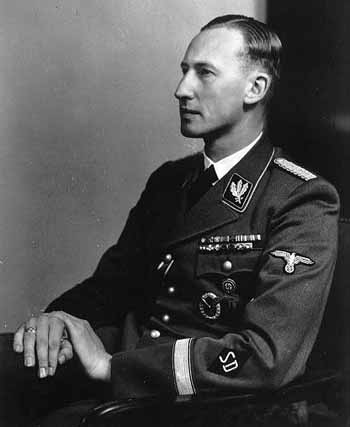 Heinrich
Himmler is made Chief of German Police & empowered to unify control of
police duties in Reich, with a position as State Secretary in the Interior
Ministry. Himmler is responsible for legal matters concerning the
press/carrying of arms/arms traffic/passports/personnel issues concerning
police officials.
Heinrich
Himmler is made Chief of German Police & empowered to unify control of
police duties in Reich, with a position as State Secretary in the Interior
Ministry. Himmler is responsible for legal matters concerning the
press/carrying of arms/arms traffic/passports/personnel issues concerning
police officials.
Reinhard Heydrich
is placed in charge of the Sicherheitspolizei - Gestapo/criminal police/Security
service and has complete control over committal & release of prisoners from
concentration camps. Despite his best efforts Himmler refuses to give Heydrich
control of the camps themselves, leaving them in the care of Theodore Eicke. Kurt
Daluege was placed in charge of the uniformed police (Orpo) .From now on the police
are infiltrated by members of the SchutzStaffel (SS), who take increasing
numbers of posts. Many policemen join the SS.
Himmler was
overlooked in the original handing out of posts to Nazi chieftains. From February
1933 until April 1934 Himmler gradually collected control of the political
police in the Lander. With pressure from Hitler, Goering handed over de facto
control of his Gestapo (Geheime Staats Polizei) to Himmler on 20th
April 1934. This was in part pre-payment for the eradication of the Sturmabteilung (SA) as
a potent political force. Himmler’s SS was subordinated to the head of the SA,
an old crony of Hitler’s Ernst Rohm - a notorious homosexual and Himmler wanted
autonomy for his SS.
Between them
Himmler and Goering appear to have persuaded Hitler that Rohm and the SA were
planning a pre-emptive strike on power. Rohm had made public his plans for the SA
to take over defence of the Reich from the Reichswehr. In 1934 Hitler still
needed the support of the army generals, who felt threatened by Rohm’s plans.
The SA by this time numbered over 3 million members.
To many Germans
the SA seemed out of control, with SA members attacking German citizen’s at
will, happy to wear their uniforms while creating mayhem. On the 31st
January members of the SA burst into the Hotel Kaiserhof in Berlin & broke
up an army officers’ celebration of the Kaiser's birthday.
 |
| Himmler with Rohm |
There was
conflict between Hitler and Rohm. Many of the SA believed in the socialism
implicit in the name of the National Socialist party. They and Rohm believed in
a ‘second’ revolution that Hitler had refused to contemplate. The result of the
pressures, at the head of the Nazi state, was the downfall of Rohm and his SA during
the Night of the Long Knives, engineered by Himmler and Goering. The SS took
the lead role in the killings on 30th June 1934, ordered by Hitler.
The SA survived, although Rohm did not, in a truncated form that never again
held any real political power.
Himmler
continued to build on his control of the political police, by working towards
take-over of the ordinary police. The Interior Minister Wilhelm Frick (who was
eventually to be replaced by Himmler in 1943) was also planning to take control
of the German police. During the latter part of 1935 and the first half of 1936
Frick attempted to persuade Hitler to
place him in control. It took a two pronged attack led by Himmler and Heydrich
to persuade Hitler that his best interests would be served by giving control of
security to his loyal Heinrich.
 On the 22nd
June Heydrich notified the Interior Ministry that Himmler had increased his demands
to absorb a number of sections & desks in the ministry & consolidate
complete control over police affairs. It was in this manner that power
gradually became consolidated in Prinz Albrechtstrasse, where Himmler and
Heydrich had taken up residence after April 1934.
On the 22nd
June Heydrich notified the Interior Ministry that Himmler had increased his demands
to absorb a number of sections & desks in the ministry & consolidate
complete control over police affairs. It was in this manner that power
gradually became consolidated in Prinz Albrechtstrasse, where Himmler and
Heydrich had taken up residence after April 1934.
The merging
of roles of Reichsfuhrer SS & the Chief of German Police was significant in
Himmler’s rise to take complete control of the German security apparatus.
Control of and merging of the two organisations created a whole greater than
the sum of its parts. The SS became synonymous with terror. The SS was to play
major roles in the Austrian Anschluss in March 1938 and the incorporation of
the Czech Sudetenland in October 1938 as well as the outright annexation of the
remainder of Czechoslovakia in March the following year. By the time war broke
out in September the core of the future Waffen SS was already blooded in the
Czech take-over.
The name of
the Gestapo resonates even today; though few people know of its head and the
game changing death of Reinhard Heydrich, in June 1942. This led to the vengeful
levelling of the Czech village of Lidice and the murder of its inhabitants; all
a direct result of the events of 17th June 1936.
Bibliography
Hitler’s Enforcers – George Browder,
Oxford University Press 1996
Foundations of the Nazi Police State –
George Browder, University of Kentucky Press 2004
Heinrich Himmler – Peter Longerich,
Oxford University Press 2011
Heinrich Himmler – Roger Manvell &
Heinrich Fraenkel, Greenhill & Lionel Leventhal 2007
Himmler – Reichsfuhrer SS – Peter
Padfield – Cassell & Co 2001
En.wikipedia.org
An excellent and informative summary.
ReplyDelete